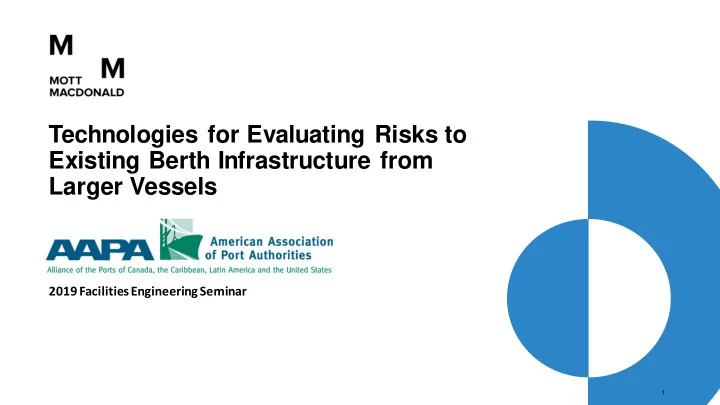

Technologies for Evaluating Risks to Existing Berth Infrastructure from Larger Vessels 2019 Facilities Engineering Seminar 1
Risks Posed by Larger Vessels 1. Navigation 2. Passing other docks 3. Maneuvering at berth 4. Berthing 5. Mooring 6. (other) 2
Navigation CMA CGM Ben Franklin Port of Oakland, CA Comprehensive vessel accommodation study, included maneuvering, surge effects, berthing and mooring. Particular CMA CGM Ben Franklin Length Overall (ft) 1309 Breadth (ft) 177 Moulded Depth (ft) 99 Draft (ft) 52.5 3
Navigation CMA CGM Ben Franklin Port of Oakland, CA Maneuvering simulations define suitable environmental conditions, pilot procedures, and data for surge analysis. Simulations at CA Maritime Academy 4
Navigation CMA CGM Ben Franklin Port of Oakland, CA High resolution PPU equipment provide better maneuvering guidance and accuracy than available on many vessels. Pilots required the PPUs with 2 nd pilot for VLCVs over 1200’ LOA. 5
Navigation CMA CGM Ben Franklin Port of Oakland, CA Navigation practice re- enacted after simulations. Surge effects were single greatest concern for pilots. Simulations provide accurate data for simulation of surge effects. 6
Passing Other Docks (Surge Effects) Surge effects are nothing new… http://www.maritimequest.com/liners/titanic_page_6.htm https://www.belfasttelegraph.co.uk/news/northern-ireland/titanic-near- 7 miss-that-could-have-changed-course-of-history-30636858.html
Passing Other Docks (Surge Effects) Surge effects are nothing new… …but good understanding of surge effects is recent. Many facilities do not have adequate consideration of surge effects. 8
Passing Other Docks (Surge Effects) CMA CGM Ben Franklin Port of Oakland, CA Surge modeling performed using maneuvering patterns taken from full bridge. Loads imposed by passing ships can rival wind loads during storm events. Surge modeling results used to evaluate mooring risk, develop navigation guidance. 9
Passing Other Docks (Surge Effects) CMA CGM Ben Franklin Port of Oakland, CA Mooring simulations help define risk to berth infrastructure from bypassing. Evaluates motions, downtime, fenders, bollards, mooring lines. 10
Passing Other Docks (Surge Effects) Safe Mooring Use Caution Potentially Unsafe CMA CGM Ben Franklin Port of Oakland, CA Bypassing guidance can be Pilot Bypassing Guidance developed for better 6.0 understanding of risks. 5.0 Passing Speed [kts] 4.0 3.0 + 2.0 1.0 0.0 0 100 200 300 400 500 Clear Distance Between Hulls at Midships [ft] 11
Passing Other Docks (Surge Effects) Cruise T erminal 3 Port Canaveral Surge effects simulated Port- wide for mooring design, and bunkering safety analysis. CT3 12
Passing Other Docks: Bunkering Cruise T erminal 3 Port Canaveral LNG bunker barges are relatively small → passing ship surge forces should be manageable. Surge-related challenges are mostly spatial conflicts, and development of suitable mooring arrangements. https://www.portcanaveral.com/getattachment/About/LNG-at-Port-Canaveral/LNG-Bunkering-Info.pdf.aspx?lang=en-US 13
Maneuvering at Berth Propulsion systems on new/larger vessels can affect berth stability CFD simulations are now routine and efficient. FLOW3D Azipods at 50% applied power, directed 45 deg aft Azipods at 50% applied power, directed starboard 14
Propulsion Effects and Scour Protection CFD analysis demonstrates shortcomings in existing systems, or new efficient designs. 15
Fender Suitability for Larger Vessels Port of Oakland Berth Infrastructure Risk Assessment Burkhart et al (PIANC Working Group 145) Fender capacity guidelines (e.g. 20 10k TEU PIANC) are intended for new 14k TEU installations. Berthing Velocity [cm/s] 19k TEU 15 10 Some recommendations should not necessarily be applied to evaluate 5 risks to existing systems. 0 Data show lower impact velocities for 0 50000 100000 150000 200000 250000 300000 larger vessels. DWT 16
Fender Suitability for Larger Vessels Port of Oakland Berth Infrastructure Risk Assessment Probability of different berthing velocities can be quantified. Combined with consequences, can inform risks of utilizing existing fenders. ~10 yr ~2.5 yr Berthing Velocity (cm/s) 17
Fender Suitability for Larger Vessels Port of Oakland Berth Infrastructure Risk Assessment Real-world experience shows that this makes sense. Pilot procedures for VLCVs • 2 pilots • 4 tugs • Daylight • Wind/current/tide/draft restrictions • PPU equipment Low berthing velocities + low berthing angles = High Loads in Existing Fenders are NOT Likely 18
Bollard Suitability for Larger Vessels Port of Oakland Berth Infrastructure Risk Assessment AIS data show that vessels don’t necessarily leave the dock during wind events. High bollard loads are possible, and probability should be evaluated with site-specific wind data. 1193’ ship at berth during 30-knot winds Ships > 1100’ LOA at berth 19
Bollard Suitability for Larger Vessels Port of Oakland Berth Infrastructure Risk Assessment Risks to bollards are berth-specific. Not all berths need the same bollards to achieve safe mooring. Some berths with lower bollard SE Winds 300 capacities may still have lower risk. 250 Bollard Load (kips) 200 150 100 50 0 0 10 20 30 40 50 Wind Speed (kts) 1yr wind 10yr wind SE Winds 20
Fender and Bollard Suitability for Larger Vessels - Conclusions High RISK Medium Low ▪ Risk is not only about probability, but also consequence. ▪ Risk can be quantified. 1. Define probabilities using suitable analysis. Consequence 2. Define consequences using damage evaluation. 3. Combination of these informs risk. ▪ Accommodating larger vessels may carry acceptable level of risk for existing Probability fenders/bollards. Bollard Load Edge Beam Fender Load +0.75 21
Summary ▪ New, larger vessels bring new potential risks. ▪ Analysis tools can help understand/minimize risks. ▪ A prepared analysis toolkit can be deployed very quickly upon notice of imminent larger vessels. +0.75 22
Technologies for Evaluating Risks 2019 Facilities Engineering Seminar to Existing Berth Infrastructure from Larger Vessels Scott W. Fenical, PE, D.CE, D.PE Coastal Practice Leader Questions? T +1 (415) 773 2164 C +1 (415) 341 4669 Scott.Fenical@mottmac.com 23
Recommend
More recommend